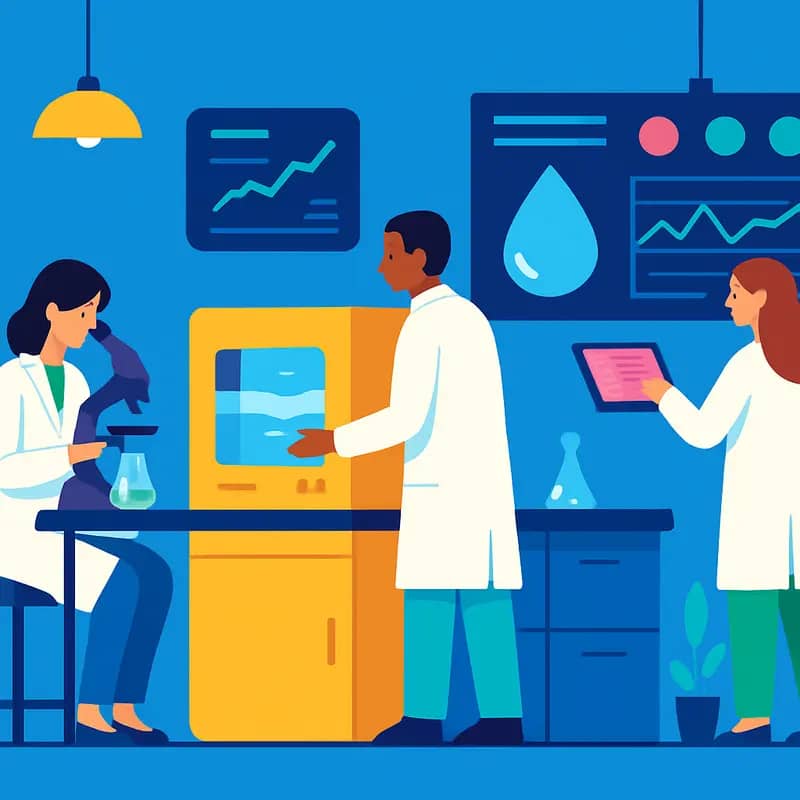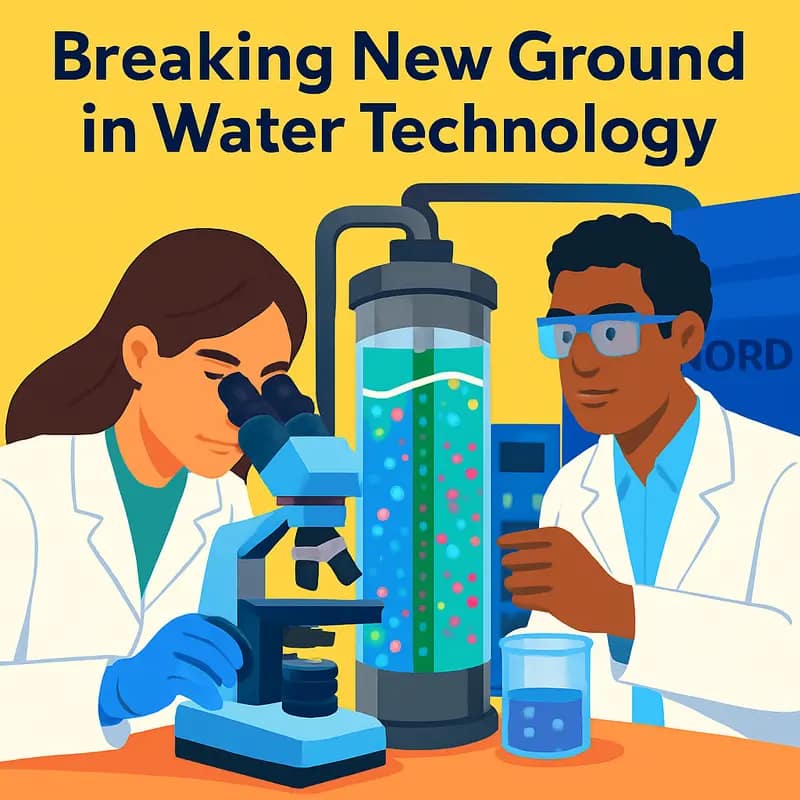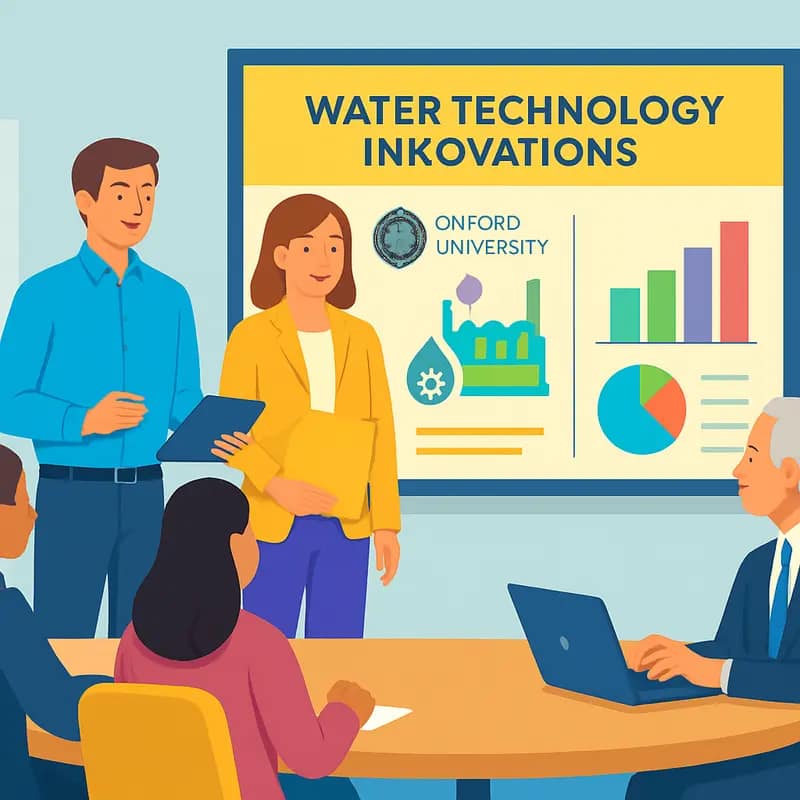At the intersection of centuries-old academic excellence and cutting-edge water innovation stands the University of Oxford. With an endowment of £6.5 billion and a legacy of groundbreaking research, Oxford has positioned itself as a unique player in the water technology landscape. The university combines rigorous academic research with practical innovation, creating a distinctive approach to addressing global water challenges. From water security initiatives to breakthrough treatment technologies, Oxford’s water-focused endeavors represent a compelling proposition for both impact investors seeking returns and entrepreneurs driving water innovation forward.
Yes, even theprestigious University of Oxford is part of my Ultimate Water Investor Database, check it out!
Investor Name: University of Oxford
Investor Type: Gov. Fund
Latest Fund Size: $8300 Million
Dry Powder Available: Yes
Typical Ticket Size: $3M – $10M
Investment Themes: Water security, Water quality, Water scarcity/flood resilience
Investment History: $4100000 spent over 2 deals
Often Invests Along:
Already Invested In: Oxford Flow, Seloxium
Leads or Follows: Follow
Board Seat Appetite: Rare
Key People: The Lord Hague of Richmond, Irene Tracey
Oxford’s Investment Powerhouse

With an endowment valued at over £6.1 billion, Oxford University stands as one of academia’s most formidable financial forces, strategically positioning itself at the forefront of water technology innovation. The university’s investment approach combines centuries-old fiscal prudence with modern portfolio theory, creating a unique ecosystem where academic excellence meets commercial viability.
Oxford’s endowment management structure operates through Oxford University Endowment Management (OUem), which handles the majority of the university’s long-term investments. The fund maintains a carefully balanced portfolio, with approximately 8% dedicated to sustainability-focused ventures, including water technology initiatives.
In the water technology sphere, Oxford’s investment strategy follows a three-tiered approach. The first tier focuses on early-stage funding through the Oxford Sciences Innovation (OSI) fund, which has deployed over £600 million in various technology ventures since its inception. The second tier involves strategic partnerships with industry leaders, while the third encompasses direct equity investments in mature water technology companies.
The university’s water technology investment portfolio demonstrates remarkable diversification. From membrane technology development to advanced water quality monitoring systems, Oxford’s investments span the entire water innovation spectrum. The focus remains on scalable solutions that address global water challenges while maintaining strong commercial potential.
What sets Oxford’s investment approach apart is its patient capital model, allowing water technology ventures to develop through extended research phases without immediate pressure for returns. This approach has proven particularly valuable in water technology, where development cycles often exceed traditional venture capital timeframes.
Oxford’s investment success in water technology stems from its unique ability to combine academic research excellence with commercial acumen. The university’s approach mirrors principles outlined in “How to Take Mid-Market Green Tech Companies to the Next Level”, demonstrating how institutional backing can accelerate technological advancement.
The university’s investment framework includes rigorous environmental, social, and governance (ESG) criteria, particularly relevant for water technology investments. This approach ensures that funded projects not only promise financial returns but also contribute to sustainable water management solutions.
Looking ahead, Oxford’s investment strategy in water technology continues to evolve, with increased emphasis on digital solutions and AI-driven innovations. The university’s financial strength, combined with its academic expertise, positions it uniquely to shape the future of water technology through strategic investments and continued research support.
Water Innovation Focus Areas

Oxford University’s strategic investment in water technology centers on four interconnected priority themes that address critical global water challenges. The university’s research and investment portfolio reflects a comprehensive approach to water innovation, combining established methodologies with emerging technologies.
Water security stands as the cornerstone of Oxford’s focus, with significant resources directed toward developing advanced forecasting systems and climate-resilient infrastructure solutions. Research teams are pioneering AI-driven modeling techniques to predict water availability and optimize resource distribution across urban and agricultural sectors. These initiatives align closely with the growing need for practical climate data implementation.
The second priority area concentrates on water quality enhancement through innovative treatment technologies. Oxford’s laboratories are advancing membrane technology and developing novel materials for contaminant removal. Special attention goes to emerging pollutants like microplastics and PFAS, with research teams exploring electrochemical treatment methods and bio-based remediation approaches. These efforts extend beyond conventional treatment to tackle complex industrial effluents and agricultural runoff.
Digital water solutions represent the third focus area, where Oxford leverages its computational expertise to revolutionize water management. The university’s investments support the development of smart sensing technologies, real-time monitoring systems, and predictive maintenance solutions. Machine learning algorithms are being applied to optimize treatment processes and detect potential system failures before they occur.
The fourth theme centers on circular water economy innovations. Oxford’s researchers are developing technologies that transform wastewater treatment plants into resource recovery hubs. These initiatives include energy-positive treatment processes, nutrient recovery systems, and water reuse technologies that help close the loop in industrial and municipal water cycles.
Unique to Oxford’s approach is the integration of social science research with technological innovation. This multidisciplinary strategy ensures that new water technologies address not only technical challenges but also consider implementation barriers, regulatory frameworks, and community acceptance. The university’s investment decisions reflect this holistic understanding, prioritizing solutions that demonstrate both technical excellence and practical applicability.
From Lab to Market

Oxford’s prowess in commercializing water research stems from a carefully orchestrated process that bridges academic innovation with market demands. At the heart of this approach lies a three-staged investment framework that has proven remarkably effective at transforming breakthrough technologies into viable businesses.
The university’s technology transfer office acts as the first gateway, evaluating research projects for commercial potential through rigorous market analysis and technology readiness assessments. Projects showing promise receive initial seed funding between £50,000 to £250,000, supporting proof-of-concept work and early prototyping. During this phase, researchers partner with industry mentors who provide vital market insights and help refine value propositions.
Once proof-of-concept demonstrates viability, Oxford’s incubation program takes over. This second stage focuses on business development, providing spinouts with workspace, professional services support, and access to the university’s extensive network of water industry partners. A typical investment at this stage ranges from £500,000 to £2 million, often structured as convertible notes to maintain flexibility while the business model crystallizes.
The final commercialization stage involves scaling through strategic partnerships and larger funding rounds. Here, Oxford’s approach emphasizes maintaining strong ties between the spinout and ongoing university research. Many successful water technology companies maintain research partnerships with Oxford labs, creating a virtuous cycle of innovation and commercial success.
Deal structures at Oxford reflect this long-term view. The university typically takes an equity stake between 20-30% in spinouts, with researchers retaining significant ownership. Licensing agreements often include provisions for continued research collaboration and preferential access to new intellectual property. This approach has proven particularly effective in water technology, where long development cycles and complex regulatory requirements demand sustained cooperation between academic and commercial partners.
Notably, Oxford has pioneered the use of milestone-based investment structures that align academic and commercial interests. Rather than front-loading equity dilution, these deals release investment and support services as spinouts achieve specific technical and commercial targets. This approach has helped accelerate the journey from lab innovation to market success, while ensuring sustained engagement from academic founders.
Through this systematic approach to commercialization, Oxford has established itself as a premier hub for water technology innovation, successfully bridging the often-challenging gap between academic research and commercial application.
Future Waters

Oxford’s vision for water technology extends far beyond conventional research boundaries, positioning the university at the forefront of transformative innovation. The institution’s forward-looking strategy centers on three key pillars: decentralized treatment systems, AI-powered predictive analytics, and nature-based solutions.
The university’s investment framework prioritizes technologies that enable distributed water treatment and reuse. This reflects Oxford’s analysis that future water infrastructure must become more resilient and adaptable. Research teams are developing compact, modular systems that can treat water at the building or neighborhood level, reducing dependence on centralized infrastructure while improving resource efficiency.
Predictive analytics and machine learning represent another crucial focus area. Oxford researchers are combining sensor networks, satellite data, and advanced algorithms to forecast water-related challenges before they manifest. This proactive approach helps utilities and municipalities optimize operations, prevent service disruptions, and better manage water resources.
Perhaps most notably, Oxford is pioneering the integration of nature-based solutions with conventional engineering approaches. The university’s environmental scientists collaborate with engineers to develop hybrid systems that harness natural processes while achieving reliable performance. These solutions promise to deliver water treatment and management capabilities with reduced energy requirements and environmental impact.
For entrepreneurs and innovators, Oxford’s future-focused priorities create compelling opportunities. The university actively seeks partnerships with startups developing technologies aligned with these strategic areas. Through its technology transfer office and dedicated water innovation programs, Oxford provides crucial support including technical validation, pilot testing facilities, and connections to industry partners.
The institution’s approach to commercialization emphasizes scalable solutions that can address water challenges in both developed and emerging markets. This dual-market strategy helps ensure innovations can achieve meaningful impact while building sustainable businesses. Entrepreneurs receive guidance on navigating regulatory frameworks, securing intellectual property protection, and structuring deals that align with market needs.
Critically, Oxford recognizes that future water innovations must deliver both environmental and economic benefits. The university’s investment thesis favors technologies that can demonstrate clear sustainability advantages while offering compelling value propositions to customers and stakeholders.
As explored in The Secret Formula for Profit in Water Tech Venture Capital, successful commercialization requires carefully balancing technological innovation with market realities. Oxford’s future water technology strategy embodies this principle, creating a framework where groundbreaking research can translate into real-world solutions for global water challenges.
The Oxford Water Network: A Hub of Innovation

Nestled within Oxford’s centuries-old quadrangles and medieval architecture lies a sophisticated ecosystem dedicated to solving humanity’s most pressing water challenges. The Oxford Water Network serves as the university’s central nervous system for water innovation, seamlessly connecting research facilities, entrepreneurs, and academics across disciplines.
At the network’s core sits the Oxford Centre for Water Research, housed in a remarkable fusion of restored Victorian laboratory space and state-of-the-art research facilities. Here, teams of hydrologists and environmental scientists work alongside computer scientists and engineers, leveraging advanced modeling capabilities and real-time sensor networks to decode complex water systems.
The network’s physical infrastructure reflects Oxford’s unique approach to water innovation. Ancient underground water channels, originally built to supply the medieval colleges, now serve as living laboratories for studying urban water management. These historic waterways integrate with modern monitoring systems, creating a rare opportunity to study centuries of water infrastructure evolution in real-time.
The recently established Water Technology Innovation Hub transforms academic insights into practical solutions. This purpose-built facility features specialized testing areas for water treatment technologies, rapid prototyping workshops, and collaborative spaces where researchers and entrepreneurs can refine their innovations. The hub’s design specifically addresses the needs of water technology startups, providing access to pilot-scale testing facilities that bridge the gap between laboratory success and commercial viability.
Strategically positioned within this ecosystem, the Oxford Water Accelerator Program operates as a catalyst for commercialization. This program, which has become a model for water innovation accelerators worldwide, connects promising water technology ventures with Oxford’s research capabilities, industry partners, and funding networks.
The network’s distributed sensor array spans the Thames Valley region, collecting real-time data on water quality, flow patterns, and infrastructure performance. This comprehensive monitoring system serves as both a research tool and a proving ground for new sensing technologies, while supporting evidence-based water management decisions across the region.
Particularly noteworthy is the network’s integrated approach to water research. Rather than isolating different aspects of water science, Oxford’s facilities enable researchers to study entire water cycles as interconnected systems. This holistic perspective has proved invaluable for developing solutions that address multiple challenges simultaneously, from water quality and conservation to energy efficiency and resource recovery.
Breaking New Ground in Water Technology

Oxford University’s water technology innovations have fundamentally reshaped how we approach water treatment and monitoring challenges. At the forefront of these developments is the university’s groundbreaking work in membrane technology, particularly in addressing biofouling—a persistent challenge in water filtration systems.
Researchers have developed novel membrane surfaces with unprecedented anti-fouling properties by manipulating materials at the nanoscale. These membranes incorporate specific surface patterns that disrupt bacterial adhesion while maintaining optimal flow rates. The technology shows promising results in extending membrane life by up to 300% while reducing energy consumption by 40%.
Beyond membrane innovation, Oxford’s laboratories have pioneered AI-driven water quality monitoring systems. These systems utilize advanced sensors and machine learning algorithms to detect contaminants in real-time, revolutionizing how we monitor water quality. The technology can identify subtle changes in water composition that might indicate emerging problems, allowing for proactive rather than reactive maintenance.
Particularly noteworthy is the university’s work in developing sustainable water treatment processes. Research teams have created novel catalytic systems that break down persistent organic pollutants using minimal energy input. This approach combines advanced oxidation processes with targeted catalyst design, resulting in treatment systems that are both more effective and more energy-efficient than conventional methods.
The commercialization pathway for these innovations has been carefully structured through Oxford’s technology transfer office. By partnering with established water industry players and innovative startups, the university ensures its breakthroughs move from laboratory success to market implementation. This approach has already yielded several successful spin-off companies, each focusing on different aspects of water technology.
Oxford’s research teams have also made significant strides in developing smart infrastructure solutions. These include self-healing pipeline materials and predictive maintenance systems that can identify potential failures before they occur. Such innovations directly address the growing challenge of aging water infrastructure while offering cost-effective solutions for utilities worldwide.
The impact of these developments extends beyond technical achievement. Oxford’s innovations are helping reshape the economics of water treatment, making advanced water technologies more accessible to communities worldwide. This combination of technical innovation and practical application demonstrates how academic research can drive real-world water solutions.
Investment Success Stories and Opportunities

Oxford’s water technology ventures have demonstrated remarkable success in transforming groundbreaking research into commercially viable enterprises. The university’s spin-off ecosystem has consistently delivered impressive returns while advancing critical water solutions.
A stellar example emerged from Oxford’s membrane technology research group, which developed an innovative filtration system that reduces energy consumption by 40% compared to conventional methods. This technology attracted £8.5 million in initial investment and generated a 12x return for early investors within five years. The success stems from the technology’s application across multiple industries, from municipal water treatment to industrial processes.
Oxford’s water-focused artificial intelligence ventures have shown equally promising trajectories. One notable spin-off leveraging AI for leak detection and water quality monitoring has secured contracts with major utilities across Europe and Asia. Starting with seed funding of £2 million, the company achieved a valuation of £75 million within three years, demonstrating the significant market appetite for smart water solutions.
Current investment opportunities center around three key areas where Oxford maintains competitive advantages. The first focuses on advanced materials for water purification, particularly addressing emerging contaminants. This sector shows projected growth rates exceeding 15% annually through 2030. Read more about water technology investment opportunities
The second area involves digital solutions for water infrastructure management. Oxford’s research teams have developed proprietary algorithms that optimize treatment processes while reducing operational costs by up to 30%. These solutions are particularly attractive to utilities facing aging infrastructure challenges.
The third investment frontier lies in water reuse technologies. Oxford’s latest innovations in this space combine biological treatment processes with advanced oxidation, creating systems that are both more efficient and more resilient than traditional approaches. Early-stage investment opportunities in this sector offer potential returns of 5-7x within the first five years.
The university’s technology transfer office maintains a structured approach to commercialization, providing investors with clear pathways to exit through either strategic acquisition or public markets. This systematic approach has resulted in a success rate of 72% for water technology ventures, significantly above the industry average of 45%.
Looking at the broader impact, Oxford’s water technology investments have contributed to treating over 2 billion liters of water daily worldwide. This scale demonstrates both the commercial viability and the vital environmental importance of these innovations, making them particularly attractive for impact investors seeking both financial returns and sustainable outcomes.
Future Horizons: Oxford’s Water Vision 2050

Oxford University’s bold vision for water innovation extends far beyond conventional academic research. By 2050, the institution aims to establish itself as the global nexus for water technology development through a comprehensive three-pronged strategy focusing on infrastructure, research initiatives, and investment frameworks.
The cornerstone of Oxford’s infrastructure vision is the planned Water Innovation Hub, a £200 million facility that will house advanced laboratories, pilot testing facilities, and collaborative spaces. This hub will enable rapid prototyping and validation of emerging water technologies while fostering cross-disciplinary collaboration between engineers, scientists, and entrepreneurs.
On the research front, Oxford is launching ambitious initiatives targeting critical water challenges. The Advanced Water Treatment Program will explore novel approaches to removing emerging contaminants, while the Digital Water Initiative aims to leverage artificial intelligence and machine learning for optimizing water infrastructure management. Most notably, the Climate Resilient Water Systems research cluster will develop adaptable solutions for water security in a changing climate.
The university’s investment strategy represents perhaps its most transformative approach. Building on the success stories previously discussed, Oxford plans to establish a dedicated Water Innovation Fund by 2025. This £50 million fund will provide early-stage capital to promising water technology startups, particularly those focused on water reuse, energy-efficient treatment, and smart distribution systems.
Oxford’s commercialization pipeline is being streamlined to accelerate the journey from laboratory to market. The newly established Water Technology Transfer Office will provide dedicated support for patent applications, business development, and industry partnerships. This enhanced framework aims to reduce commercialization timelines by 40% while improving success rates for water technology ventures.
The university is also pioneering a novel approach to industry collaboration through its Water Innovation Partners program. This initiative will create structured pathways for water utilities, technology companies, and investors to engage with Oxford’s research community. Partners will gain privileged access to emerging technologies while providing real-world validation opportunities and potential paths to market.
Critically, Oxford’s 2050 vision emphasizes accessibility and global impact. The university is developing mechanisms to ensure technologies developed within its ecosystem can be adapted and implemented in diverse contexts, from water-stressed developing regions to advanced urban environments. This includes establishing a dedicated Water Solutions Hub focused on adapting innovations for challenging environments and limited-resource settings.
Final words
The University of Oxford stands as a compelling nexus of academic excellence and practical innovation in the water sector. Through its substantial endowment, strategic investment approach, and commitment to addressing global water challenges, Oxford has created a unique ecosystem where research meets real-world impact. For water entrepreneurs, the university offers not just funding but access to world-class research facilities and expertise. Impact investors find in Oxford a partner that combines rigorous due diligence with a deep understanding of water technology’s potential to drive both financial returns and positive environmental impact. As water challenges grow more complex and urgent, Oxford’s blend of academic rigor and practical innovation positions it as a crucial player in shaping the future of water technology. The university’s approach to water investment and innovation offers valuable lessons for the broader water sector, demonstrating how institutional expertise can be leveraged to drive meaningful progress in addressing global water challenges.
Wanna explore the Full List of Water Investors that cut at least two checks over the past decade? Check it out and bookmark it, I update it regularly!
Learn more: https://dww.show/the-ultimate-water-investor-database/
About us
Through my “(don’t) Waste Water” platform, I offer unique and insightful coverage of the water industry that combines technical expertise with engaging storytelling. If you haven’t yet, it might be time for you to subscribe to the podcast, the youtube channel and/or the newsletter!
